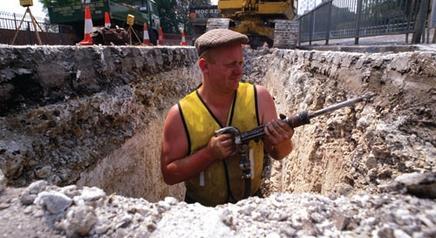As a recent NFB survey has found, connecting your site to gas, water and electricity can be a real headache for contractors. Brian Moone and Bob Hollingsworth explain the form
As the lead time on utility infrastructure work can be anything up to 18 months, it is worth giving priority to it in your project programme. Although this lead time does not fluctuate with demand in the same way as some of the other major programme items, it is all too often underestimated, and this can have significant implications for the project. Typically, a project will require new connections or the abandonment of existing services, and in a town or city centre it is likely that the existing services will need to be diverted to accommodate the project construction programme. As the utilities industry is regulated, this is an area of the programme that is outside the direct control of the project manager, who often finds dealing with utilities companies
time-consuming and frustrating. The client generally bears the risk and potentially the cost of a statutory authority’s delay, so it is important that adequate provision is made in the programme and that once set, it is adhered to.
The table opposite provides an indication of the times that should be allowed for the stages of the utility infrastructure work. These timings are may be greatly extended where the infrastructure is physically large. Finding new routes for large diameter pipes in densely packed urban environments is time-consuming, and crossing barriers such as railways or canals will add significant delay to the programme – six months is not uncommon. The stakeholders responsible for these barriers have to protect their own interests as these will be outside the direct control of the utility companies. It may not always be obvious that a major reroute is necessary; this may be dictated by the lack of space for the excavation to make the connection and therefore require a lengthy reroute, potentially crossing major barriers to find suitable space to carry out this work.
Although it is acceptable to construct most of the diverted infrastructure using your own contractors, the utility companies own the assets and are responsible for service delivery. The utility therefore has to approve the work in advance, monitor progress and oversee connections. They will also commission the works and agree to adopt the programme. There are no short cuts in this process.
However, the statutory utilities companies do have a duty to provide support services to a published standard and are answerable to their regulator. This should at least provide a level of programme certainty. They have to manage every project that is sent to them and provide trained resources to do this.
The key is to give the utilities companies early sight of the project, establish a relationship with them as soon as possible and nurture that relationship through the programme of works. It is therefore essential to find out what infrastructure is on or next to the site by commissioning the necessary studies. In addition to helping to determine the impact on a programme, it is also a duty of the client under CDM 2007 regulations to provide this information to the designers. The earlier the information is collected and verified the better the solutions for dealing with any conflict.
The value of some of this work may be less than £100 but the process or service won’t start until payment has been received.
Co-ordinated services drawings should be developed and overlaid on the project design in order to determine the impacts of the infrastructure. This information can be used to generate a utilities programme.
Budget estimates for work should be commissioned from the utilities companies but formal estimates must be commissioned before any works can be programmed. It is worth mentioning that it is common practice for utility companies to ask for payment in advance of providing services, be they designs, commercial reviews, or construction. The value of some of this work may be less than £100 but the process or service won’t start until payment has been received. It is worth agreeing a procurement strategy with the commercial team at the start of the project. This is a simple step that often gets overlooked and can lead to frustrating delays.
The utilities companies build their construction programmes on a first come, first served basis after receipt of payment so project programme dates cannot be planned beyond the current date. Leave it to the last minute and you may be facing a very long lead time. In addition you should factor in holidays where utilities contractors close their sites. You also should not expect utility companies to keep every type and size of pipe and cable in stock; some items may take up to three months to procure.
Where works are required on the public highway, the utilities companies have to seek permission from the highways manager for permit to dig. The rules of engagement are detailed in the Traffic Management Act 2007. As a general rule, the notice period is three months from receipt of application by the highways authority and this will not start until the money has been paid in advance and the work formally requested by the project manager. Under certain circumstances, the notice period can be six months.
These procedures are laid down in law and no protestations from projects managers will change this. Owing to the ever-increasing complexity involved in dealing with the utilities companies, projects are beginning to call upon specialist support from consultants.
Postscript
Brian Moone is operations director of the Mace Business School and Bob Hollingsworth is services co-ordination manager with the Mace Group’s utilities sector




























No comments yet